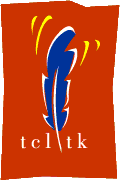Contents
Tcl/Tk Tutorial - Create GUI using Tk with Tcl Language
A Tcl(Tutorial for Cool Languages) for Tcl/Tk

Tcl/Tk - one language, many uses. It can be used for GUI(Graphical User Interface) development with the powerful TK. Tcl/Tk runs as a plugin from web browsers made by Netscape and Microsoft. So it can be used instead of JavaScript and VBScript. It is a CGI language and can be used in servers. Tcl-Tk is also extremely extendable - Tcl/Tk is valuable to C/C++ programmers who want to learn a high-level scripting language for their user interfaces or for integrating pieces of a large system.
Tcl stands for Tool Command Language. Tcl and Tk, its associated graphical user interface toolkit, was created by Professor John Ousterhout of the University of California, Berkeley. Tcl is a scripting language that runs on Windows, UNIX and Macintosh platforms. Tk is a standard add-on to Tcl that provides commands to quickly and easily create user interfaces. Even though Tcl was originally created on UNIX, your Tcl/Tk scripts should run the same on all supported platforms, except for a few differences.
Tcl is a very simple, open-source-licensed programming language and provides basic language features such as variables, procedures, and control, and it runs on almost any modern OS, such as Unix, Macintosh, and Windows 95/98/NT/XP computers.
Tcl was originally developed as a reusable command language for experimental computer aided design(CAD) tools. The interpreter was implemented as a C library that could be linked into any application. It is very easy to add new functions to the Tcl interpreter, so it is an ideal reusable "macro language" that can be integrated into many applications.
But Tcl is a programming language in its own right, which can be roughly described as a cross-breed between LISP/Scheme (with less parens) and shells (with more powerful structuring). You can write any number of programs in Tcl, just as you can in any other language. Tcl programs are usually called "scripts" because the programs do not need to be compiled into a machine-readable form.
Enough history(..yawn..). Now lets move on to the tutorial. Go to the contents page - or skip straight to the important parts.
Author - Binny V A
About the Author
Personal Site Binny V A
Tutorial Feedback
